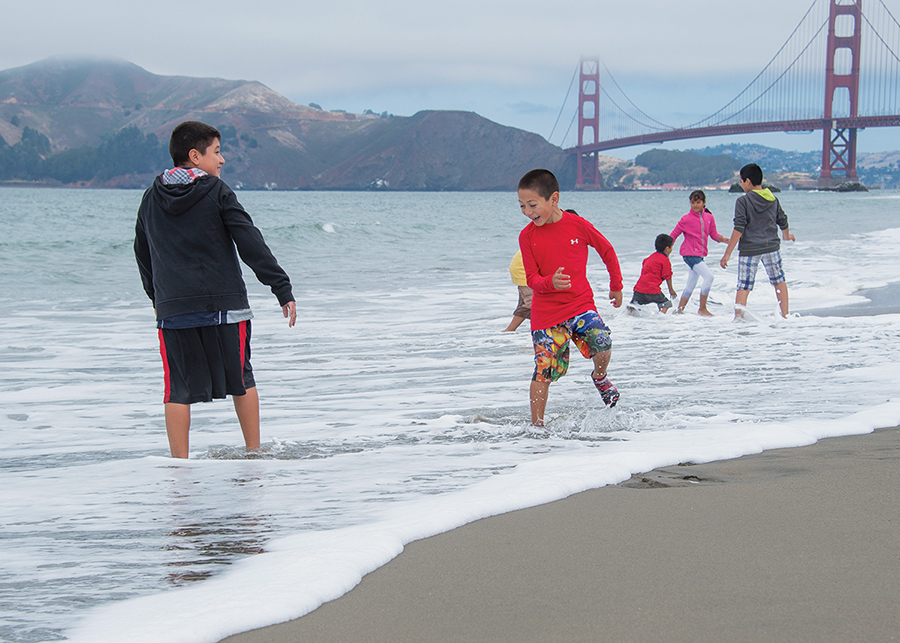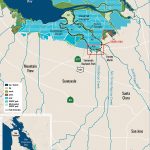
The Coastal Conservancy’s new call for proposals continues the agency’s efforts to fund equitable recreational access to the coast, like the Community Shuttle program that brought these kids to Baker Beach in 2014. Photo by Alison Taggart-Barone, Golden Gate National Parks Conservancy.
In just a few years, Monterey Bay will have a new campground with 40 tent sites, 45 RV sites, and 10 walk-in or bike-in sites. The property for Fort Ord Dunes State Park was acquired in 1995 and opened as a state park to the public in 2009. The new campground will provide affordable overnight accommodations in a popular coastal tourist area with few low-cost options to spend the night.
“I have a feeling it will be filled up on day one. People like to camp in coastal areas,” said Patricia Clark-Gray, interpretive specialist with the state parks department’s Monterey District. She reported that the campground is estimated to open in late 2021.
The planned campground at Fort Ord Dunes State Park is listed as an example of a low-cost coastal accommodation in the State Coastal Conservancy’s draft assessment for the agency’s Explore the Coast Overnight program. In 2017, the California legislature enacted Assembly Bill 250 (Gonzalez Fletcher), which called for the Coastal Conservancy to develop a program that addresses the scarcity of affordable overnight accommodations for lower- and middle-income individuals and families visiting the coast. Last year’s Proposition 68 designated $60 million for the program, with $30 million going to projects within the state parks department, which owns one-third of California’s coast. The other $30 million will be distributed by the Coastal Conservancy through grants. The agency recently gathered public comments on the assessment and will release a final document in March.
The Coastal Conservancy expects to put out a call for proposals this summer with two types of projects being sought. About 95 percent of the funds will go toward projects that increase the number of low-cost coastal accommodations (including campsites, cabins, hostels, and motels) through new construction and acquisitions or the expansion of existing ones. Up to 5 percent of the funding will support efforts that increase the use of accommodations by people with lower incomes and people of color, such as those that provide outreach, environmental education, outdoor gear loans, transportation, and reservation system improvements. Project partners will include non-profits, agencies such as the Presidio Trust and Hosteling International, and private hotel developers that can ensure public benefit.
The California Coastal Act of 1976 gave all Californians equal right to access the state’s coastline, but economic factors can erect barriers to keep people from enjoying the coast equitably. In the last few years, several studies have addressed the issue. Parks Forward, an independent commission created to help the state parks department update services and address California’s changing demographics, advised an increase in overnight options to mitigate inequity. The Institute of the Environment and Sustainability at UCLA also did a study and reported that while the “coast and beaches are among our most democratic spaces,” access is becoming a problem due to limited affordable overnight options.
For their own assessment, the Coastal Conservancy conducted a statewide phone survey. The survey found that 90 percent of Californians relate emotionally to the state’s shoreline even when they aren’t near it. It also found that although many Californians visit the coast, most of them don’t deepen their experience by spending the night, especially those who are younger, are in a lower-income family, or are people of color. The survey concluded that the luxury of staying overnight is primarily reserved for those who are white, over 55 years old, and have incomes above $200,000. While more than half of people who live within 150 miles of the coast are low-income, only 21 percent of all coastal accommodations are lower cost.
Camping can be a good option for low-cost coastal accommodations. It can also be fun. For some, the night sky and hoot of an owl create awe. Others spend the night on the coast to deepen ties with family and friends. But for those who have never done anything like it, the experience can prove profound.
“Staying overnight adds a layer of resiliency,” said Andrea Fraume, outreach coordinator for Bay Area Wilderness Training (BAWT), a project of the non-profit Earth Island Institute. BAWT’s mission is to create equitable access to outdoor experiences for youth of color and low-income youth. Fraume said that “sleeping on the ground when it’s cold can be scary, but when done in a group with a mentor, it can be really powerful. It’s especially meaningful to marginalized youth who have experienced trauma.” Trauma, she added, can result from living in poverty, being bullied, or encountering racism as a person of color.
Omar Gallardo, the outreach and diversity director for LandPaths, said a senior-class trip to Yosemite changed his life. As a kid growing up near Geyserville, Gallardo’s family rarely went to the coast, and when they did it was a treat that his parents had saved for. They never spent the night. In college, Gallardo witnessed what being outside could mean to others. He worked with a program that took the children of Latino, Laotian Hmong, and Asian Indian migrant farmworkers camping for a week. “They didn’t speak the same language, but the outdoors brought them together. They could dance and share the same trails. It was beautiful,” he said.
There are more barriers at play to keeping the coast equitable. “There’s an intimidation factor just to go hiking or camping, let alone being at the coast,” said Gallardo. “I don’t want to speak for all Latinos or people of color, but many Latino families don’t necessarily want to spend the night outdoors anywhere. You have a house for a reason. At LandPaths we try to overcome cultural barriers and at least offer opportunities.”
LandPaths offers no- or low-cost outings to Sonoma County residents, including some overnight camping trips. A lack of outdoor gear can be a barrier, and even when they have it, they aren’t confident that they’re using it right, said Gallardo.
“Equipment is a huge barrier,” said Scott Wolland, BAWT’s executive director. In addition to providing wilderness training to teachers and others who work with youth, the nonprofit operates three gear libraries, including one in Oakland that can outfit over 500 people for an outing. Upon completion of a BAWT training program, gear rental is free for individuals who serve low-income youth and youth of color. “We provide free equipment to most of our groups, which helps them to have a safe and awesome experience to broaden their world,” Wolland said.
Reserving a campground or cabin can also pose a challenge. “People who have free time and know how to make the system work are the ones who get the reservations,” said Wolland. Even teachers who know their way around technology find the systems difficult, he said, noting that “ways to make these systems more equitable might include reservation set-asides, or free and low-cost permits issued to non-profit community groups in advance.”
In the Explore the Coast Overnight draft assessment, the Coastal Conservancy offers examples of projects beyond new or expanded campsites. Other low-cost coastal accommodations given as examples are in various stages of the planning process. These include plans to build 13 cabins at Angel Island State Park, the enlargement of a bunkhouse at Jug Handle Creek Farm and Nature Center on the Mendocino Coast, and an expansion of the hostels at Pigeon Point and Point Montara lighthouses.
It takes work and money to bring equity to the outdoor world. “I’ve heard hollow words all over the nation from the movement to get people of color outside. If you mean it, you must invest in it,” said LandPaths’ Gallardo. “Offering first contact is worth the investment. It’s not just for us, it’s for our babies.”
Aleta George covers open space for the Monitor.

